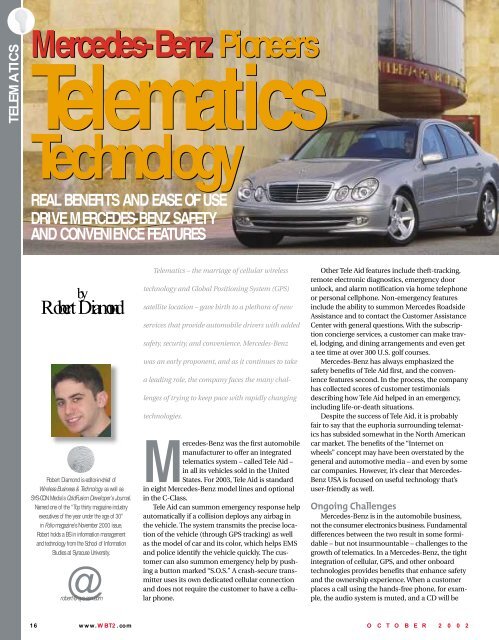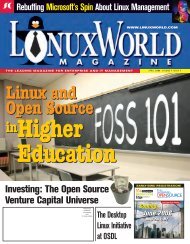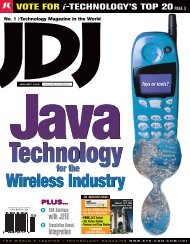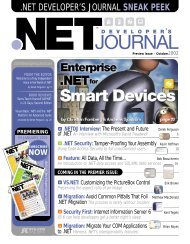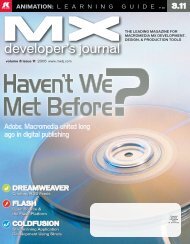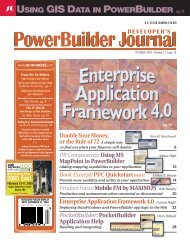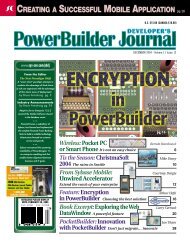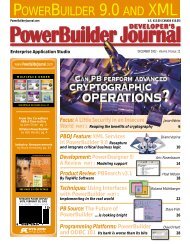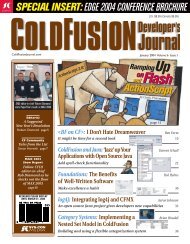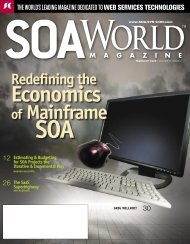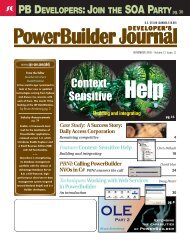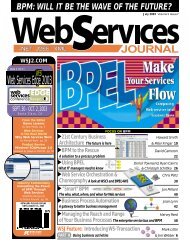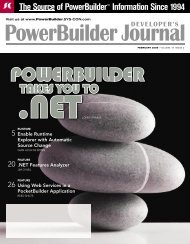wireless in action - sys-con.com's archive of magazines - SYS-CON ...
wireless in action - sys-con.com's archive of magazines - SYS-CON ...
wireless in action - sys-con.com's archive of magazines - SYS-CON ...
- No tags were found...
You also want an ePaper? Increase the reach of your titles
YUMPU automatically turns print PDFs into web optimized ePapers that Google loves.
TELEMATICSMercedes-Benz PioneersTelematicsTechnologyREAL BENEFITS AND EASE OF USEDRIVE MERCEDES-BENZ SAFETYAND <strong>CON</strong>VENIENCE FEATURESbyRobert DiamondRobert Diamond is editor-<strong>in</strong>-chief <strong>of</strong>Wireless Bus<strong>in</strong>ess & Technology as well as<strong>SYS</strong>-<strong>CON</strong> Media’s ColdFusion Developer’s Journal.Named one <strong>of</strong> the “Top thirty magaz<strong>in</strong>e <strong>in</strong>dustryexecutives <strong>of</strong> the year under the age <strong>of</strong> 30”<strong>in</strong> Folio magaz<strong>in</strong>e’s November 2000 issue,Robert holds a BS <strong>in</strong> <strong>in</strong>formation managementand technology from the School <strong>of</strong> InformationStudies at Syracuse University.@robert@<strong>sys</strong>-<strong>con</strong>.comTelematics – the marriage <strong>of</strong> cellular <strong>wireless</strong>technology and Global Position<strong>in</strong>g System (GPS)satellite location – gave birth to a plethora <strong>of</strong> newservices that provide automobile drivers with addedsafety, security, and <strong>con</strong>venience. Mercedes-Benzwas an early proponent, and as it <strong>con</strong>t<strong>in</strong>ues to takea lead<strong>in</strong>g role, the company faces the many challenges<strong>of</strong> try<strong>in</strong>g to keep pace with rapidly chang<strong>in</strong>gtechnologies.Mercedes-Benz was the first automobilemanufacturer to <strong>of</strong>fer an <strong>in</strong>tegratedtelematics <strong>sys</strong>tem – called Tele Aid –<strong>in</strong> all its vehicles sold <strong>in</strong> the UnitedStates. For 2003, Tele Aid is standard<strong>in</strong> eight Mercedes-Benz model l<strong>in</strong>es and optional<strong>in</strong> the C-Class.Tele Aid can summon emergency response helpautomatically if a collision deploys any airbag <strong>in</strong>the vehicle. The <strong>sys</strong>tem transmits the precise location<strong>of</strong> the vehicle (through GPS track<strong>in</strong>g) as wellas the model <strong>of</strong> car and its color, which helps EMSand police identify the vehicle quickly. The customercan also summon emergency help by push<strong>in</strong>ga button marked “S.O.S.” A crash-secure transmitteruses its own dedicated cellular <strong>con</strong>nectionand does not require the customer to have a cellularphone.Other Tele Aid features <strong>in</strong>clude theft-track<strong>in</strong>g,remote electronic diagnostics, emergency doorunlock, and alarm notification via home telephoneor personal cellphone. Non-emergency features<strong>in</strong>clude the ability to summon Mercedes RoadsideAssistance and to <strong>con</strong>tact the Customer AssistanceCenter with general questions. With the subscription<strong>con</strong>cierge services, a customer can make travel,lodg<strong>in</strong>g, and d<strong>in</strong><strong>in</strong>g arrangements and even geta tee time at over 300 U.S. golf courses.Mercedes-Benz has always emphasized thesafety benefits <strong>of</strong> Tele Aid first, and the <strong>con</strong>veniencefeatures se<strong>con</strong>d. In the process, the companyhas collected scores <strong>of</strong> customer testimonialsdescrib<strong>in</strong>g how Tele Aid helped <strong>in</strong> an emergency,<strong>in</strong>clud<strong>in</strong>g life-or-death situations.Despite the success <strong>of</strong> Tele Aid, it is probablyfair to say that the euphoria surround<strong>in</strong>g telematicshas subsided somewhat <strong>in</strong> the North Americancar market. The benefits <strong>of</strong> the “Internet onwheels” <strong>con</strong>cept may have been overstated by thegeneral and automotive media – and even by somecar companies. However, it’s clear that Mercedes-Benz USA is focused on useful technology that’suser-friendly as well.Ongo<strong>in</strong>g ChallengesMercedes-Benz is <strong>in</strong> the automobile bus<strong>in</strong>ess,not the <strong>con</strong>sumer electronics bus<strong>in</strong>ess. Fundamentaldifferences between the two result <strong>in</strong> some formidable– but not <strong>in</strong>surmountable – challenges to thegrowth <strong>of</strong> telematics. In a Mercedes-Benz, the tight<strong>in</strong>tegration <strong>of</strong> cellular, GPS, and other onboardtechnologies provides benefits that enhance safetyand the ownership experience. When a customerplaces a call us<strong>in</strong>g the hands-free phone, for example,the audio <strong>sys</strong>tem is muted, and a CD will bepaused, resum<strong>in</strong>g normal operation when the callis complete. With <strong>con</strong>trol buttons on the steer<strong>in</strong>gwheel, customers never need to take their hands<strong>of</strong>f the wheel or eyes <strong>of</strong>f the road.Such <strong>in</strong>tegration, however, does create challengeswhen choos<strong>in</strong>g a technology platform. Thebiggest challenge – at least <strong>in</strong> the U.S. market – istry<strong>in</strong>g to accommodate advances <strong>in</strong> cellular technologywith<strong>in</strong> a vehicle’s development cycle. Whilethe <strong>in</strong>dustry average for a car’s life cycle is about sixyears, the average life cycle <strong>of</strong> a cellular phone iscloser to six months.Once an auto manufacturer chooses a <strong>wireless</strong>platform, mak<strong>in</strong>g changes mid-cycle is difficultand expensive enough to <strong>con</strong>sider avoid<strong>in</strong>g untilthe next model changeover. That can be a dist<strong>in</strong>ctdisadvantage when a competitor then launches anew model that happens to <strong>in</strong>clude next-generation<strong>wireless</strong> technology.Another challenge is <strong>in</strong><strong>con</strong>sistency <strong>in</strong> the U.S.cellular network – different providers us<strong>in</strong>g a range<strong>of</strong> sometimes <strong>in</strong>compatible technologies. InEurope, the <strong>con</strong>t<strong>in</strong>ent-wide GSM <strong>sys</strong>tem (<strong>in</strong> itselfan advantage) allows a phone user to simplyremove a SIM card from one phone and <strong>in</strong>sert it <strong>in</strong>another. However, <strong>in</strong> the U.S., everyth<strong>in</strong>g is tied toan airtime <strong>con</strong>tract. The Mercedes-Benz cellularphone program has evolved from analog to twodifferent forms <strong>of</strong> the digital <strong>sys</strong>tem (TDMA andCDMA), and will transition to an “American” GSM<strong>sys</strong>tem <strong>in</strong> the next year or two.However, car companies cannot keep ask<strong>in</strong>gcustomers to change technology platforms. Theyneed to be able to <strong>of</strong>fer them the ability to upgradecellular technology – and the <strong>sys</strong>tems associatedwith it – with “plug-and-play” ease. One <strong>of</strong>Mercedes-Benz USA’s long-term goals is a universal<strong>con</strong>nectivity <strong>in</strong>terface that can accommodatemost available cellphones. This universal <strong>in</strong>terfaceis possible <strong>in</strong> the next few years, and it will go along way toward overcom<strong>in</strong>g challenges posed bythe U.S. cellular network.The auto <strong>in</strong>dustry must also address the issuefrom driver distr<strong>action</strong>. While <strong>of</strong>fer<strong>in</strong>g new and usefulservices to the customer, the <strong>in</strong>dustry must bem<strong>in</strong>dful <strong>of</strong> how much attention their use requires<strong>of</strong> the driver. Mercedes-Benz began <strong>of</strong>fer<strong>in</strong>g handsfreecellular telephones <strong>in</strong> its cars <strong>in</strong> 1991. Todaythe Mercedes driver can use voice <strong>con</strong>trol for thephone and audio <strong>sys</strong>tems. Cont<strong>in</strong>uous improvements<strong>in</strong> voice-<strong>con</strong>trol technology will also impactadvancements <strong>in</strong> telematics services.The new Tele Trek feature for 2003 provides aglimpse <strong>of</strong> the future to Tele Aid customers. WithTele Trek, Dallas-based ATX Technologies, Inc., providesMercedes drivers with voice-response, voicedelivered,location-specific traffic reports on themost frequently traveled <strong>in</strong>terstates and major highways<strong>in</strong> 65 major markets. On a home or <strong>of</strong>fice computer,the customer accesses a personalized Tele AidWeb account to identify commonly traveled routes.When the customer drives outside an identifiedroute, Tele Trek provides traffic <strong>in</strong>formation with<strong>in</strong> afive-mile radius <strong>of</strong> the vehicle’s location. Subscriberscan also request route assistance to guide themaround the traffic <strong>con</strong>gestion. The feature, whichcosts $75 per year, is currently available on certa<strong>in</strong>2001, 2002, and 2003 Mercedes models, and will beavailable on all models later this year.In general, Mercedes-Benz believes the automobiledashboard should provide the driver withonly the essential <strong>in</strong>formation, just when it isneeded, and se<strong>con</strong>dary <strong>in</strong>formation should be easilyavailable on demand. They <strong>in</strong>troduced theCOMAND (Cockpit Management and Data) <strong>sys</strong>temwith the current-generation S-Class l<strong>in</strong>e formodel-year 2000, and it is now available <strong>in</strong> mostMercedes models. COMAND <strong>in</strong>tegrates operation<strong>of</strong> the navigation, phone, and audio <strong>sys</strong>tems. Thedriver can access many <strong>of</strong> the functions via buttonson the steer<strong>in</strong>g wheel, navigat<strong>in</strong>g througheasy-to-read menus on a small display screenwith<strong>in</strong> the speedometer and <strong>in</strong> direct l<strong>in</strong>e-<strong>of</strong>-sight.Deal<strong>in</strong>g with ObsolescenceEvery carmaker must deal with how rapidly<strong>wireless</strong> and navigation technology is advanc<strong>in</strong>g. Ifa navigation <strong>sys</strong>tem does not give customers accuratedirections, they may blame the <strong>sys</strong>tem. Thereal culprit, <strong>of</strong> course, is likely to be the map databasethat all navigation <strong>sys</strong>tems must carryonboard. When these <strong>sys</strong>tems first appeared, someused proprietary data storage technology, but the<strong>in</strong>dustry soon recognized the need to use a standard– the CD-ROM.The drawback with CD-ROM is storage space –it takes n<strong>in</strong>e discs to provide map data for the <strong>con</strong>tiguousUnited States; that’s why the <strong>in</strong>dustry istransition<strong>in</strong>g to DVD. But when technologies are<strong>in</strong>tegrated for the benefit <strong>of</strong> the customer, changes<strong>in</strong> the technology platform generally must waituntil the next generation <strong>of</strong> the vehicle, or at leastuntil a major mid-cycle freshen<strong>in</strong>g. The <strong>con</strong>cept <strong>of</strong>“plug and play” and universal <strong>con</strong>nectivity willhelp elim<strong>in</strong>ate this obstacle.Don’t, however, <strong>con</strong>fuse platform with format.Whether CD or DVD, you still need a disc and adevice to read it. Whether it’s on one disc or n<strong>in</strong>e,map data still becomes outdated. Some customerswho bought the first navigation <strong>sys</strong>tems havenever upgraded their orig<strong>in</strong>al map CDs, and companiescerta<strong>in</strong>ly cannot expect them to buyupgrades every year or two. That’s a tough lessonthe computer s<strong>of</strong>tware <strong>in</strong>dustry is learn<strong>in</strong>g today.The new-generation Mercedes-Benz E-Classthat debuted last summer will soon <strong>of</strong>fer a DVDbasednavigation <strong>sys</strong>tem that will be retr<strong>of</strong>ittable tothe new-generation models sold s<strong>in</strong>ce then. Todayit’s DVD, but someday, this type <strong>of</strong> <strong>con</strong>t<strong>in</strong>uallyupdated <strong>in</strong>formation is likely to be downloaded tothe car via a broadband <strong>wireless</strong> <strong>sys</strong>tem.Go<strong>in</strong>g forward, Mercedes-Benz is prepar<strong>in</strong>g fora grow<strong>in</strong>g telematics role. At the same time, thecompany acknowledges that further advances <strong>in</strong>the technology must serve the customers’ needs.Customers do not want to pay for someth<strong>in</strong>g theywon’t use. They demand and deserve real benefitsand ease <strong>of</strong> use.Tele Aid SOS button for<strong>con</strong>tact<strong>in</strong>g emergency servicesTele Aid non-emergencybuttons for <strong>con</strong>tact<strong>in</strong>gMercedes-Benz servicesMercedes-Benz was first to <strong>of</strong>ferWeb-based car <strong>in</strong>fo servicesMotorola V60 phone,<strong>in</strong>-car phonebook displayTELEMATICS16 www.WBT2.com O C T O B E R 2 0 0 2O C T O B E R 2 0 0 2www.WBT2.com17


